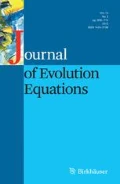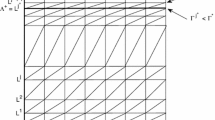Abstract
In this paper, we study a system of nonlinear hyperbolic equations, with nonlocal boundary conditions and a free boundary, arising in the modeling of epidermis growth. The model was introduced in a previous paper (Gandolfi et al. in J Math Biol 62(1):111–141, 2010) where conditions for the existence of a steady state were investigated. The present paper is devoted to prove existence and uniqueness of a solution to the evolution problem and of the related moving boundary representing the external surface of the epidermis. The proof of the theorem is based on the integration along characteristic curves in order to obtain suitable estimates allowing to set up a fixed point procedure. The modellistic aim of the paper is a description of the structure of the epidermis as a layered aggregate of different type of cells.
Similar content being viewed by others
References
Adams M.P., Mallet D.G., Pettet G.J.: Active regulation of the epidermal calcium profile. J. Theor. Biol. 301, 112–121 (2012)
Allen T.D., Potten C.S.: Ultrastructural site variation in mouse epidermal organization. J. Cell Sci. 21, 341–359 (1976)
Ambrosi D., Preziosi L.: On the closure of mass balance models for tumor growth. Math. Models Meth. Appl. Sci. 12, 737–754 (2002)
Bertuzzi A., Gandolfi A.: Cell kinetics in a tumour cord. J. Theor. Biol. 204, 587–599 (2000)
Bertuzzi A., Fasano A., Gandolfi A.: A free boundary problem with unilateral constraints describing the evolution of a tumor cord under the influence of cell killing agents. SIAM J. Math. Anal. 36, 882–915 (2004)
Byrne H.M., Preziosi L.: Modelling solid tumor growth using the theory of mixture. Math. Med. Biol. 20, 341–366 (2003)
Dyson J., Villella-Bressan R., Webb G.: The evolution of a tumor cord cell population, Comm. Pure Appl. Anal. 3, 331–352 (2004)
Friedman A., Hu B.: The role of oxygen in tissue maintenance: mathematical modeling and qualitative analysis. Math. Mod. Meth. Appl. Sci. 18, 1409–1441 (2008)
Gandolfi, A., Iannelli, M., Marinoschi, G.: An age-structured model of epidermis growth, J. Math. Biol. 62, 1, 111–141, 2010.
Hadgraft J.: Skin, the final frontier. Int. J. Pharm. 224, 1–18 (2001)
Klein-Szanto A.J.P.: Stereological baseline data of normal human epidermis. J. Invest. Dermatol. 68, 73–78 (1977)
Lowes M.A., Bowcock A.M., Krueger J.G.: Pathogenesis and therapy of psoriasis. Nature 445, 866–873 (2007)
Potten C.S.: The epidermal proliferative unit: the possible role of central basal cell proliferation. Cell Prolif. 7, 77–88 (1974)
Preziosi L., Vitale G.: A multiphase model of tumor and tissue growth including cell adhesion and plastic reorganization. Math. Models Methods Appl. Sci. 21, 1901–1932 (2011)
Savill N.J.: Mathematical models of hierarchically structured cell populations under equilibrium with application to the epidermis. Cell Prolif. 36, 1–26 (2003)
Stekel D., Rashbass J., Williams E.D.: A computer graphic simulation of squamous epithelium. J. Theor. Biol. 175, 283–293 (1995)
Webb G.: The steady state of a tumor cord cell population. J. Evol. Eqs. 2, 425–438 (2002)
Webb, G.: Population models structured by age, size, and spatial position. In: Structured population models in Biology and Epidemiology. Auger, P., Magal, P., Ruan, S. (eds.), Springer Verlag, 2008, 1–49
Weinstein G.D., McCoullog J.L., Ross P.: Cell proliferation in normal epidermis. J. Invest. Dermatol. 82, 623 (1984)
Author information
Authors and Affiliations
Corresponding author
Rights and permissions
About this article
Cite this article
Gandolfi, A., Iannelli, M. & Marinoschi, G. Time evolution for a model of epidermis growth. J. Evol. Equ. 13, 509–533 (2013). https://doi.org/10.1007/s00028-013-0188-0
Published:
Issue Date:
DOI: https://doi.org/10.1007/s00028-013-0188-0




